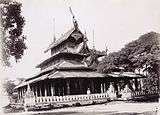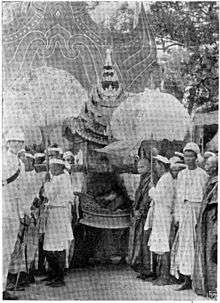Thathanabaing of Burma
| Thathanabaing of Burma
သာသနာပိုင် | |
|---|---|
| Type | Abolished |
| Appointer | King of Burma |
| Term length | Lifetime |
| Formation | c. 1400s |
| First holder | Shin Arahan |
| Final holder | Taunggwin Sayadaw |
| Abolished | 1938 |
The Thathanabaing of Burma (Burmese: သာသနာပိုင်, also spelt Thathanapaing) served as the head of the Buddhist Sangha (order of monks) in pre-colonial Burma, until its abolishment in 1938 by the British authorities in colonial Burma. The Thathanapaing was responsible for managing the monastic hierarchy and education at monasteries. The Thathanabaing resided in a royal monastery near the kingdom's capital.[1] However, appointees were usually commoners born in the villages, with no blood relationship with the royal house.[1] Their appointments were made on the basis of their mastery of Buddhist knowledge and literature.[1]
Etymology
Thathanabaing, literally 'Keeper of the Sāsana', is the native Burmese rendition of Sangharaja, or formally Mahasangharaja (မဟာသံဃာရာဇာ), which is typically rendered into English as 'Primate', 'Archbishop' or 'Supreme Patriarch.'[2] The term "Sangharaja" was popularly used from the 1300s to 1400s, but lost currency in subsequent centuries.[1] By the Konbaung dynasty, Thathanabaing and Thathanapyu (သာသနာပြု) were frequently used.[1]
History
According to Burmese chronicles, the office of the Thathanabaing dates to the reign of Swa Saw Ke (1367-1400).[3] British historians recognize a lineage of primates during the Pagan Kingdom, beginning with the monk Shin Arahan.[4]
Konbaung dynasty


The office, in its last incarnation, was established by King Bodawpaya in 1784, after the constitution of the Sudhamma Council, a council of four elder monks (thera), of which the Thathanabaing was its head.[5] Subsequent monarchs expanded the Council, which varied from 8 to 12 members called sadaw.[5][6] Council members were appointed by the king and styled Dazeitya Sayadaw (တံဆိပ်ရဆရာတော်, 'Teachers Possessing the Seal').[6]
The Thathanabaing was appointed by the king and granted supreme authority with regard to religious doctrine and ecclesiastical administration.[6] The Thathanapaing was responsible for the kingdom's religious affairs, including appointment of monastery abbots, monk orders according to the Vinaya, management of breaches of discipline, preparation of an annual report of the order, and administration of Pali examinations.[5]
The Thathanabaing was charged with managing the functions of two government officials, the Mahadan Wun (မဟာဒါန်ဝန်, Ecclesiastical Censor), who oversaw the king's charitable functions, ensured monk compliance with the Vinaya, and submitted registers of all active novices and monks, and the Wutmye Wun (ဝတ်မြေဝန်), who managed the wuttukan-designated religious properties (ဝတ္ထုကံမြေ), including donated land and pagodas.[7][8] The Burmese kingdom was divided into ecclesiastical jurisdictions, each of which was overseen by a gaing-gyok. Underneath each gaing-gyok was a number of gaing-ok, who were in turn assisted by a number of gaing-dauk.[7] Ecclesiastical disputes were settled by the gaing-gyok and decisions for appeal were made by the Sudhamma Council.[7]
Colonial rule

In 1895, soon after the abdication of the country's last king, Thibaw Min, the Taungdaw Sayadaw, then the Thathanapaing of Burma, died.[9] A subsequent election elected the Pakhan Sayadaw as Thathanabaing-elect, although the British refused to acknowledge or recognize his title.[9]
In 1903, the lieutenant-governor of British Burma, Hugh Shakespear Barnes, reinstated the title by sanad charter, giving the Thathanapaing nominal authority over internal administration of the Sangha in Upper Burma and over Buddhist ecclesiastical law.[9] (Lower Burma, which had been annexed in 1852, remained without a religious head.[10]) The Taunggwin Sayadaw was appointed, but the position was abolished after his death and no successor was ever appointed.[11]
List of Thathanabaing
Kingdom of Ava
- Yakhaing Sayadaw
- Amyint Sayadaw
Konbaung dynasty
- Atula Sayadaw
- Taungdwingyi Sayadaw
- Sayit Sayadaw
- Ashin Thapon
- Hteintabin Sayadaw
- Manle Sayadaw
- Min-o Sayadaw
- Zonta Sayadaw
- Minywa Sayadaw
- Maungdaung Sayadaw
- Salin Sayadaw
- The-in Sayadaw
- Maungdaung Sayadaw
- Bagaya Sayadaw
- Maungdaung Sayadaw
- Taungdaw Sayadaw
British rule
- Moeta Sayadaw
- Taunggwin Sayadaw
Notes
- 1 2 3 4 5 Kyaw, Aye (1984). "The Sangha Organization in Nineteenth Century Burma and Thailand" (PDF). Journal of the Siam Society.
- ↑ Twomey 1904.
- ↑ Mendelson, E. Michael (1975). Sangha and State in Burma: A Study of Monastic Sectarianism and Leadership. Cornell University Press. ISBN 9780801408755.
- ↑ James, Helen (2005). Governance and civil society in Myanmar: education, health, and environment. Psychology Press. p. 81. ISBN 978-0-415-35558-2.
- 1 2 3 James 2005, p. 81-84.
- 1 2 3 Scott 1900, p. 3.
- 1 2 3 Scott 1900, p. 4.
- ↑ Scott 1900, p. 6.
- 1 2 3 Long 1906.
- ↑ Aung San Suu Kyi 2010.
- ↑ Ghosh 2000, p. 38-39.
References
- Bennett, Charles Henry Allan (November 1904). "The Thathanabaing". Buddhism: A Quarterly Illustrated Review. Rangoon: International Buddhist Society. 1 (4): 177–208.
- Aung San Suu Kyi (2010). Freedom from Fear. Penguin. ISBN 978-1-101-56400-4.
- Ghosh, Parimal (2000). Brave Men of the Hills. University of Hawaii Press. ISBN 978-0-8248-2207-1.
- James, Helen (2005). Governance and Civil Society in Myanmar. Psychology Press. pp. 81–84.
- Long, Edward E. (January 1906). "Order of the Yellow Robe". Broad views. Gay & Bird. 5 (25).
- Scott, J. George (1900). Gazetteer of Upper Burma and the Shan states (PDF). 2. Superintendent, Government Printing.
- Twomey, D.H.R. (January 1904). "The Thathanabaing, Head of the Buddhist Monks of Burma". The Imperial and Asiatic Quarterly Review. Oriental Institute. XVII (33/34): 326–335.
See also
- Buddhism in Myanmar
- Sangharaja (Supreme Patriarch)
- Supreme Patriarch of Cambodia
- Supreme Patriarch of Thailand
- Burmese Buddhist titles